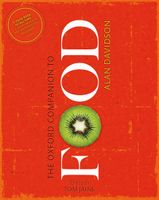Advertisement
Umeboshi
Published 2014
Japanese salted and dried ‘plums’. Umeboshi literally means ‘dried ume’. This fruit, as explained in the entry for ume, is more correctly described as a sort of apricot; but the salted and dried version is plum coloured, the flavour is like that of a tart plum rather than an apricot, and the rendering ‘plum’ has stuck. The typical purple or red colour of umeboshi is produced by red shiso leaves. Umeboshi have a wrinkled and shrivelled appearance with a sour and salty taste. Hosking (1996) explains that:
These apricots come large and small, soft and hard, and are an item of daily consumption. Usually colored red with red shiso leaves, they are mostly eaten as a pickle with rice, but the large soft ones, desalted by soaking in water, make very good tempura. A cup of [green] bancha tea containing an umeboshi makes a good start to the morning. A bento with an umeboshi on top of the rice is called hinomaru bento, after the Japanese flag. Rice gruel (kayu), a breakfast food, is usually served with umeboshi.


